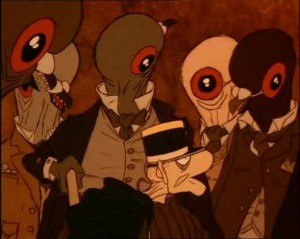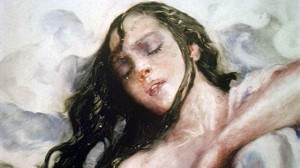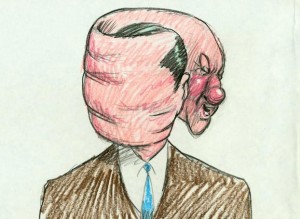Animated Matters

Steven Lisberger’s feature film Tron (1982), which has become a cult movie for a huge number of science fiction enthusiasts all over the world, is often regarded as one of the first movies which massively used computer graphics. However, what the movie shows is only partially created through the implementation of digital techniques: at that time, the level of technology did not allow live actors and digitally-created b ackgrounds to share the same shot, and some of the most evocative sequences were created by traditional cel animation. Moreover, in spite of Tron’s reputation (which is probably superior to the movie’s real artistic merits), in the ‘70s computer techniques had already been used to create some experimental short movies. In Sunstone (1979) the director Ed Emshwiller made use of almost entirely computer-generated colors and managed to create a three-dimensional effect (a rotating, expanded cube with a different image for each of its faces) almost two years before the first real system of computer graphics able to make perspective projections, the Ampex Digital Optics, which was created in 1981. Similarly, in Roger Mainwood’s music video Autobahn (1979), the director succeeded in mixing traditionally drawn animation with sequences realized in a primitive computer graphics.
Obviously, nowadays many of these experimentations seem extremely dated, and they belong to the world of video art rather than to scripted cinema. However, for two long decades, the ‘80s and the ‘90s, computer-generated movies existed side by side with traditional ani mation movies and stop motion films. Historically speaking, many of the most important computer-animated movies (like John Lasseter’s 1986 short movie Luxo Jr., whose main character, a living desk lamp, would later become Pixar’s symbol) were made in the period when the traditionallyanimated movies by Disney were experiencing their last but most important artistic rebirth (which began in 1989, with The Little Mermaid); for the first years at least, “contaminations” between the two techniques were not that rare (in The Great Mouse Detective, made in 1986, the sequences inside the Big Ben tower were created with the aid of computer graphics). In some cases, there were even some unintentional aesthetical “intersections” between the two approaches to animation: Bill Plympton’s celebrated short movie Your Face (1987) is a film focused on a vaguely Reagan-like character whose face undergoes a sort of metamorphosis leading to plastic mutations, all this while he is singing an overly the “morphing” effect, still rather primitive at the time (even if it had been implemented in Peter Foldès’ 1974 short movie La faim).
mation movies and stop motion films. Historically speaking, many of the most important computer-animated movies (like John Lasseter’s 1986 short movie Luxo Jr., whose main character, a living desk lamp, would later become Pixar’s symbol) were made in the period when the traditionallyanimated movies by Disney were experiencing their last but most important artistic rebirth (which began in 1989, with The Little Mermaid); for the first years at least, “contaminations” between the two techniques were not that rare (in The Great Mouse Detective, made in 1986, the sequences inside the Big Ben tower were created with the aid of computer graphics). In some cases, there were even some unintentional aesthetical “intersections” between the two approaches to animation: Bill Plympton’s celebrated short movie Your Face (1987) is a film focused on a vaguely Reagan-like character whose face undergoes a sort of metamorphosis leading to plastic mutations, all this while he is singing an overly the “morphing” effect, still rather primitive at the time (even if it had been implemented in Peter Foldès’ 1974 short movie La faim).
Today, computer techniques are regularly used in making animated works (even to make 2D movies computer effects are massively used) and films entirely characterized by 3D graphics, such as the Toy Story saga, which have become a model for the cinema industry. However, even if technically speaking computer graphics is extremely complex and detailed, its expressive and artistic potential is still almost entirely unexpressed, especially when we compare the movies created with this technique with those made with traditional or stop motio n techniques. Computer-generated movies are able to recreate extraordinarily plausible environments and bodies, but their smoothness somehow represents a limit to the artistic potential of these works.
n techniques. Computer-generated movies are able to recreate extraordinarily plausible environments and bodies, but their smoothness somehow represents a limit to the artistic potential of these works.
Traditional animation and stop motion techniques do not necessarily create perfectly plausible or flowing visual effects; however, their true charm lies on this imperfection. Some historically important animated movies are deliberately “dirty” in their style, or contain references to pre-existing graphic effects or painting techniques which could hardly be adopted by three-dimensional graphics. To make his movies (like the astonishing short film Rusalka of 1996, telling about a charming and lethal female ghost), Russian animator Alexander Petrov used oil paints on glass sheets, in order to create incredibly expressive “animated paintings”. The Quay brothers (Americans by birth but living in England) deliberately used damaged and rusty puppets to film their dreamlike visions in stop motion, as is the case of the Stille Nacht cycle (1988-2001). Artist Kawamoto Kihachiro’s stop motion animated dolls are rich with references to Japanese theatre, to Bunraku, No and Kabuki, and their main charm consists in their being physically existing puppets, which move on the background of cutout and painted sceneries: it is hard to think that the same effect could be recreated through computer-generated characters. It is probably not a coincidence that in several recentlymade feature films in 3D graphics, some of the most inventive, visually-rich sequences are the end credits, which are often realized in 2D animation (as in the 2013 movie Cloudy with a Chance of Meatballs 2, or WALL•E, made in 2008). Even entirely computermade motion pictures, like The LEGO Movie (2014), attempt to visually recreate the typical “jerkiness” of stop motion films, an element which is particularly appropriate for a movie whose characters live in a world made of tiny, colored bricks.
3D graphics animation is simply too recent, and it is almost impossible to foresee the evolution it will be subject to. There have been interesting artistic experiments though, even if they were generally limited to single movies or directors. Chris Landreth’s short movie Ryan (2004), a surreal documentary based on Landreth’s interview to Ryan Larkin; the Canadian animator had once been one of the most promising artists in the animation field, but later he had seriously taken to drinking and had fallen into poverty. –The author clearly emphasizes the characters’ psychological traumas by scarring and deforming their bodies. Their grotesque mutations follow the progress of their talks and their wavering psychological state, and are inspired by the works by Gunther von Hagens’ travelling exhibition Body Worlds, made of human bodies which are preserved by the anatomical technique of plastination.
Works like Ryan, though, are still too rare to outline a discernible “authorial” path for computer-generated animation. However, it is possible that the progressive diffusion of more and more financially affordable software for private users (the most famous is probably the free program Blender, which has already be en used to create technically advanced short movies, like Sintel in 2009) will open new expressive paths for this approach to animation. Future evolution, as it often happens, will probably derive from the fusion between different techniques: short movies like Paperman (2012), made by the Disney studios, are currently exploring the possibilities of harmonious “contaminations” between 2D and 3D animation, while works like Les triplettes de Belleville (2003) ) demonstrate the modernity and the endless possibilities of traditionally-drawn animation, although even if they don’t categorically discard the use of CGI (insofar as limited to very marginal elements). In the meantime stop motion, probably to be considered the oldest animation technique (one of the first stop motion short movies, Matches: an Appeal, was made in 1899, almost a decade before the works by Emile Cohl, the pioneer of animation), was revived in feature films such as ParaNorman (2012) and in the short movies made by young directors, often inspired by Jan Švankmajer, the Czech “alchemist”, one of the most important stop motion animators ever. Among the others, director PES (Adam Pesapane) should be mentioned: his films are apparently thoughtless, but in fact they are rich of original reflections on the perception and conception of matter.
en used to create technically advanced short movies, like Sintel in 2009) will open new expressive paths for this approach to animation. Future evolution, as it often happens, will probably derive from the fusion between different techniques: short movies like Paperman (2012), made by the Disney studios, are currently exploring the possibilities of harmonious “contaminations” between 2D and 3D animation, while works like Les triplettes de Belleville (2003) ) demonstrate the modernity and the endless possibilities of traditionally-drawn animation, although even if they don’t categorically discard the use of CGI (insofar as limited to very marginal elements). In the meantime stop motion, probably to be considered the oldest animation technique (one of the first stop motion short movies, Matches: an Appeal, was made in 1899, almost a decade before the works by Emile Cohl, the pioneer of animation), was revived in feature films such as ParaNorman (2012) and in the short movies made by young directors, often inspired by Jan Švankmajer, the Czech “alchemist”, one of the most important stop motion animators ever. Among the others, director PES (Adam Pesapane) should be mentioned: his films are apparently thoughtless, but in fact they are rich of original reflections on the perception and conception of matter.
Animated matter, animated paintings, animated sketches and animated objects; and now computergener ted creations, inspired by real-life models but devoid of physical substance. Expressive paths which are becoming more and more complex, almost unimaginable some decades ago. They are undoubtedly faithful to the original ideas and principles behind Cohl, Méliès, Starewicz and de Chomon’s first animated movies: the sense of entertainment, wonder and illusionism.
